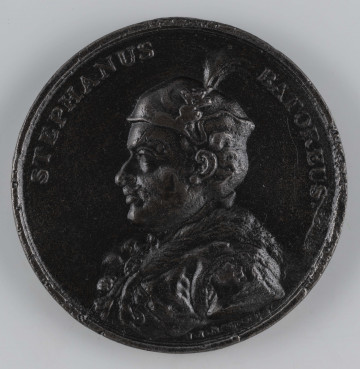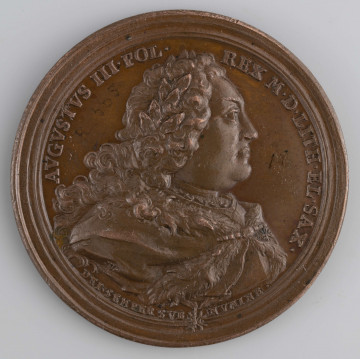
Stephen Báthory - royal entourage
1792 — 1797
National Museum in Lublin
Part of the collection: Polish medallic art from the 16th to the 17th c.
This medal, or rather coronation token, was attributed to the French Mannerist sculptor Germain Pillon. However, the surviving bills issued to the Paris mint indicate that it was designed by a lesser-known medallist, Aubin Oliver. The medal was minted to celebrate the accession of Henry III of France [Henryk Walezy] to the Polish throne. Catherine de' Medici, the mother of the future king of Poland, decided to commemorate this through artistic events. One of the customs at that time was the minting of commemorative medals-tokens. It was customary to scatter them among the crowd present at the coronation. In the case of the presented medal, it is worth paying attention to the meaning of the motifs presented on it. This concerns especially the reverse. On the obverse, as is customary in such cases, there is the bust of the newly elected king. On the reverse there is a scene depicting a seaside landscape with two boats in the foreground and a hill with a fortress and a windmill in the distance. On the right, half of a radiant sun disk is visible above the horizon. The inscription in the frame (He carries light to a foreign world) provides a clue to the meaning of the composition. In this case, the radiant sun is a symbol of Henry III of France, who arrives in a foreign country to rule there and shine with his light. As we can see, long before Louis XIV, members of the French royal family liked to present themselves in the form of the sun. The boats shown in the foreground may refer to the planned way of Henry's arrival in Poland. Although he eventually came to Krakow by land, originally a sea journey was planned.
Interestingly, the short episode related to the reign of Henry III of France in Poland found artistic expression not only in the form of the presented medal. It also became the subject of a peculiar poetic polemic between the French poet Philippe Desportes, who accompanied Henry during his stay in Poland, and Jan Kochanowski. In 1576 in Paris Desportes published a work entitled Adieu à la Pologne, which was full of malice towards Poland. Our poet replied with the ironic Gallo crocitanti αμοιβη.
Leszek Poniewozik
Author / creator
Dimensions
cały obiekt: width: 29,4 mm
Object type
medal
Technique
stamp minting
Material
bronze
Creation time / dating
Creation / finding place
Owner
The National Museum in Lublin
Identification number
Location / status

1792 — 1797
National Museum in Lublin

1764
National Museum in Lublin

1745
National Museum in Lublin
DISCOVER this TOPIC
National Museum in Lublin
DISCOVER this PATH
Educational path